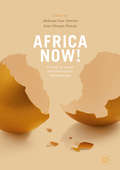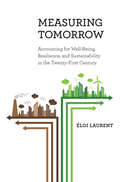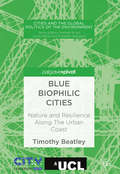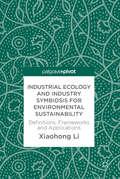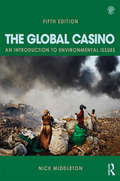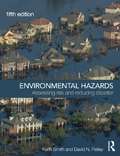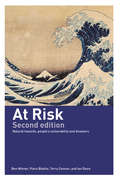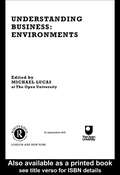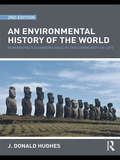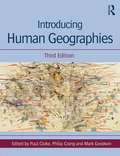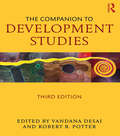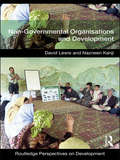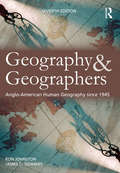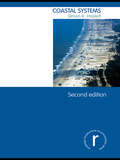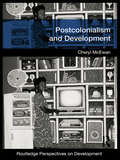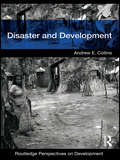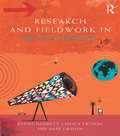- Table View
- List View
Africa Now!: Emerging Issues and Alternative Perspectives
by Adebusuyi Adeniran Lanre IkuteyijoThis book presents relevant and timely endogenous procedures for addressing the challenge of transforming ideas into sustainable opportunities in Africa. It explores how Africa could be understood in the context of emerging global realities, providing alternative frameworks that will not just be participatory in conception and practice, but equally show a contextual workability for the varying aspects of the developmental enterprise in Africa. Despite having alternative and less cumbersome sources of funding, with commendable economic growth indices, and several economies among the fastest growing globally, African countries have been unable to transmute related opportunities into sustainable human development outcomes for majority of its citizenry. Over four rich sections the authors cover subjects ranging from environment and natural resource management, to governance, economy and sustainable development. The book continues with a section on Education and Human Development and a case study in transnationalism. The final section discusses crime, conflict and regional dynamics, including highly disputed topics such as forced migration and sex trade.This indispensable resource will be of great use to students and researches globally in fields such as sociology, anthropology, environmental studies, politics and economics with a focus on contemporary Africa, as well as to policy planners and human rights activists invested in the future development of Africa.
Measuring Tomorrow: Accounting for Well-Being, Resilience, and Sustainability in the Twenty-First Century
by Éloi LaurentHow moving beyond GDP will improve well-being and sustainabilityNever before in human history have we produced so much data, and this empirical revolution has shaped economic research and policy profoundly. But are we measuring, and thus managing, the right things—those that will help us solve the real social, economic, political, and environmental challenges of the twenty-first century? In Measuring Tomorrow, Éloi Laurent argues that we need to move away from narrowly useful metrics such as gross domestic product and instead use broader ones that aim at well-being, resilience, and sustainability. By doing so, countries will be able to shift their focus away from infinite and unrealistic growth and toward social justice and quality of life for their citizens.The time has come for these broader metrics to become more than just descriptive, Laurent argues; applied carefully by private and public decision makers, they can foster genuine progress. He begins by taking stock of the booming field of well-being and sustainability indicators, and explains the insights that the best of these can offer. He then shows how these indicators can be used to develop new policies, from the local to the global.An essential resource for scholars, students, and policymakers, Measuring Tomorrow covers all aspects of well-being—including health, education, and the environment—and incorporates a broad range of data and fascinating case studies from around the world: not just the United States and Europe but also China, Africa, the Middle East, and India.
Measuring Tomorrow: Accounting for Well-Being, Resilience, and Sustainability in the Twenty-First Century
by Éloi LaurentHow moving beyond GDP will improve well-being and sustainabilityNever before in human history have we produced so much data, and this empirical revolution has shaped economic research and policy profoundly. But are we measuring, and thus managing, the right things—those that will help us solve the real social, economic, political, and environmental challenges of the twenty-first century? In Measuring Tomorrow, Éloi Laurent argues that we need to move away from narrowly useful metrics such as gross domestic product and instead use broader ones that aim at well-being, resilience, and sustainability. By doing so, countries will be able to shift their focus away from infinite and unrealistic growth and toward social justice and quality of life for their citizens.The time has come for these broader metrics to become more than just descriptive, Laurent argues; applied carefully by private and public decision makers, they can foster genuine progress. He begins by taking stock of the booming field of well-being and sustainability indicators, and explains the insights that the best of these can offer. He then shows how these indicators can be used to develop new policies, from the local to the global.An essential resource for scholars, students, and policymakers, Measuring Tomorrow covers all aspects of well-being—including health, education, and the environment—and incorporates a broad range of data and fascinating case studies from around the world: not just the United States and Europe but also China, Africa, the Middle East, and India.
Climate And Sustainability Communication: Global Perspectives (PDF)
by Donnalyn PompperClimate and Sustainability Communication: Global Perspectives builds upon traditional approaches to understanding the role of mass media in shaping social issues by amplifying diverse perspectives of opinion leaders, as well as voices of those affected by climate and sustainability issues. From South Korea and China, to the United States and Zambia, the studies reported in this book#65533;compiled using a variety of formal research methods, including content analysis, interview, and survey#65533;emphasize cultural orientation and global implications of climate and sustainability concerns and issues. The contributors explore the cultures, geographies, and media systems underpinning climate and sustainability campaigns emerging around the world, how we theorize about them, and the ways in which media are used to communicate about them. The way in which complex problems and opportunities associated with globalization and power inequities interplay with climate and sustainability communication requires creative, interdisciplinary, approaches. This book opens new conversations for integrating scholarly arenas of mass media communication, science and environmental communication, political communication, and health communication, as well as their respective theory and research method sets. This book was originally published as a special issue of Mass Communication and Society.
Blue Biophilic Cities: Nature and Resilience Along The Urban Coast
by Timothy BeatleyThere is a growing recognition of the contact we need with nature to be happy, healthy and to lead meaningful lives. We need that nature daily, if not hourly, and so it must be nearby to where we live and work. This is central to the concept of ‘biophilic cities’ which is emerging as a global movement and guiding framework for city design and planning. Blue Biophilic Cities is about the promise of this movement and a kind of biophilic urbanism that is possible for cities perched on the edge of harbours and seas. In blue biophilic cities, much of the nearby nature is to be found in the marine realm. This book explores the efforts underway in a number of cities to foster new marine connections through a variety of innovative programs and initiatives. It also discusses a number of design ideas, from dynamic shoreline edges and floodable parks to living breakwaters, in order to emphasise the possibility of designing for resilience while also supporting marine biodiversity and strengthening biophilic connections to the marine world.
Blue Biophilic Cities: Nature and Resilience Along The Urban Coast
by Timothy BeatleyThere is a growing recognition of the contact we need with nature to be happy, healthy and to lead meaningful lives. We need that nature daily, if not hourly, and so it must be nearby to where we live and work. This is central to the concept of ‘biophilic cities’ which is emerging as a global movement and guiding framework for city design and planning. Blue Biophilic Cities is about the promise of this movement and a kind of biophilic urbanism that is possible for cities perched on the edge of harbours and seas. In blue biophilic cities, much of the nearby nature is to be found in the marine realm. This book explores the efforts underway in a number of cities to foster new marine connections through a variety of innovative programs and initiatives. It also discusses a number of design ideas, from dynamic shoreline edges and floodable parks to living breakwaters, in order to emphasise the possibility of designing for resilience while also supporting marine biodiversity and strengthening biophilic connections to the marine world.
Industrial Ecology and Industry Symbiosis for Environmental Sustainability: Definitions, Frameworks and Applications
by Xiaohong LiThis book opens up a critical dimension to the interdisciplinary field of Industrial Ecology (IE) and one of its four areas - Industrial Symbiosis (IS). Presenting the concept of closed-loop thinking, this timely book explains how industries and societies can achieve environmental sustainability, a necessity for today’s businesses. Providing a critical review of the definitions and developments of both IE and IS, this study establishes their fundamental role in improving environmental sustainability. The author identifies valuable lessons to be learned and presents conceptual frameworks to guide future IE and IS applications. Transforming industrial systems into closed-loop industrial ecosystems dramatically reduces the negative impact of industrial activities on the environment. Therefore, this book is an important read not only for operations management scholars, but also those who are interested in ensuring an environmentally sustainable future.
Industrial Ecology and Industry Symbiosis for Environmental Sustainability: Definitions, Frameworks and Applications
by Xiaohong LiThis book opens up a critical dimension to the interdisciplinary field of Industrial Ecology (IE) and one of its four areas - Industrial Symbiosis (IS). Presenting the concept of closed-loop thinking, this timely book explains how industries and societies can achieve environmental sustainability, a necessity for today’s businesses. Providing a critical review of the definitions and developments of both IE and IS, this study establishes their fundamental role in improving environmental sustainability. The author identifies valuable lessons to be learned and presents conceptual frameworks to guide future IE and IS applications. Transforming industrial systems into closed-loop industrial ecosystems dramatically reduces the negative impact of industrial activities on the environment. Therefore, this book is an important read not only for operations management scholars, but also those who are interested in ensuring an environmentally sustainable future.
The Global Casino
by Nick MiddletonThe Global Casino is an introduction to environmental issues which deals both with the workings of the physical environment and the political, economic and social frameworks in which the issues occur. Using examples from all over the world, the book highlights the underlying causes behind environmental problems, the human actions which have made them issues, and the hopes for solutions. It is a book about the human impact on the environment and the ways in which the natural environment impacts human society. The fifth edition has been fully revised and updated throughout, with new case studies, figures, and online resources such as downloadable figures and tables from the text and multiple choice questions for students, accessible at: www. routledge. com/cw/middleton. New topics covered in extended boxed case studies include payment for environmental services, ocean acidification, biofuels in Brazil, waste reduction through industrial symbiosis, and the long-term impact of natural disasters on vulnerable groups. Other approaches and concepts covered for the first time in this new edition include traditional ecological knowledge, environmental justice, the resource curse, and urban biodiversity. Eighteen chapters on key issues follow three initial chapters which outline the background contexts of the physical and human environments and the concept of sustainable development. Each chapter provides historical context for key issues, outlines why they have arisen, and highlights areas of controversy and uncertainty to appraise how issues can be resolved both technically and in political and economic frameworks. Each chapter also contains an updated critical guide to further reading and websites, as well as discussion points and essay questions. The text can be read in its entirety or individual chapters adopted as standalone reading. The Global Casino is an essential resource for students of the environment, geography, earth sciences and development studies. It provides comprehensive and inspirational coverage of all the major global environmental issues of the day in a style that is clear and critical. "
Environmental Hazards
by Keith Smith David N. PetleyThe expanded fifth edition of Environmental Hazards provides a balanced overview of all the major rapid-onset events that threaten people and what they value in the twenty-first century. It integrates cutting-edge material from the physical and social sciences to demonstrate how natural and human systems interact to place communities of all sizes, and at all stages of economic development, at risk. It also shows how the existing losses to life and property can be reduced. Part I of this established textbook defines basic concepts of hazard, risk, vulnerability and disaster. Critical attention is given to the evolution of theory, to the scale of disaster impact and to the various strategies that have been developed to minimise the impact of damaging events. Part II employs a consistent chapter structure to explain how individual hazards, such as earthquakes, severe storms, floods and droughts, plus biophysical and technological processes, create distinctive patterns of loss throughout the world. The ways in which different societies make a positive response to these threats are placed in the context of ongoing global change. In this extensively revised edition: An entirely new and innovative chapter explains how modern-day complexity contributes to the generation of hazard and risk Additional material supplies fresh perspectives on landslides, biophysical hazards and the increasingly important role of global-scale processes The increased use of boxed sections allows a greater focus on significant generic issues and offers more opportunity to examine a carefully selected range of up-to-date case studies Each chapter now concludes with an annotated list of key resources, including further reading and relevant websites. Environmental Hazards is a well-written and generously illustrated introduction to all the natural, social and technological events that combine to cause death and destruction across the globe. It draws on the latest research findings to guide the student from common problems, theories and policies to explore practical, real-world situations. This authoritative, yet accessible, book captures both the complexity and dynamism of environmental hazards and has become essential reading for students of every kind seeking to understand the nature and consequences of a most important contemporary issue.
At Risk
by Ben Wisner Piers Blaikie Terry Cannon Ian DavisThe term 'natural disaster' is often used to refer to natural events such as earthquakes, hurricanes or floods. However, the phrase 'natural disaster' suggests an uncritical acceptance of a deeply engrained ideological and cultural myth. At Risk questions this myth and argues that extreme natural events are not disasters until a vulnerable group of people is exposed. The updated new edition confronts a further ten years of ever more expensive and deadly disasters and discusses disaster not as an aberration, but as a signal failure of mainstream 'development'. Two analytical models are provided as tools for understanding vulnerability. One links remote and distant 'root causes' to 'unsafe conditions' in a 'progression of vulnerability'. The other uses the concepts of 'access' and 'livelihood' to understand why some households are more vulnerable than others. Examining key natural events and incorporating strategies to create a safer world, this revised edition is an important resource for those involved in the fields of environment and development studies.
Understanding Business: Environments
by Michael LucasWhat are the forces shaping today's business world? Understanding Business Environments provides key readings which introduce the student to the factors underlying the business environment. Including chapters by gurus such as Anthony Giddens, Stuart Hall and Will Hutton, the book covers: * social forces including the social structure and long-term social change * technological factors including Information Technology and new production technologies * economic factors including the impact of macroeconomic policy and of the financial system * political factors including the legal environment and government-business relations.
An Environmental History of the World: Humankind's Changing Role in the Community of Life
by J. Donald HughesThis second edition of An Environmental History of the World continues to present a concise history, from ancient to modern times, of the interactions between human societies and the natural environment, including the other forms of life that inhabit our planet. Throughout their evolutionary history, humans have affected the natural environment, sometimes with a promise of sustainable balance, but also in a destructive manner. This book investigates the ways in which environmental changes, often the result of human actions, have caused historical trends in human societies. This process has happened in every historical period and in every part of the inhabited earth. The book is organized into ten chapters. The main chapters follow a chronological path through the history of mankind, in relationship to ecosystems around the world. The first explains what environmental history is, and argues for its importance in understanding the present state of the world's ecological problems. Chapters two through eight form the core of the historical analysis, each concentrating on a major period of human history (pre-civilized, early civilizations, classical, medieval, early modern, early and later twentieth century, and contemporary) that has been characterized by large-scale changes in the relationship between human societies and the biosphere, and each gives several case studies that illustrate significant patterns occurring at that time. The chapters covering contemporary times discuss the physical impacts of the huge growth in population and technology, and the human responses to these problems. Our moral obligations to nature and how we can achieve a sustainable balance between technology and the environment are also considered. This revised second edition takes account of new research and the course of history containing new sections on global warming, the response of New Orleans to the hurricanes Katrina and Rita, and the experience of the Dutch people in protecting their low-lying lands against the encroachments of rivers, lakes, and the North Sea. New material is also offered on the Pacific Islands, including the famous case of Easter Island. This is an original work that reaches further than other environmental histories. Rather than looking at humans and the environment as separate entities, this book places humans within the community of life. The relationship between environmental thought and actions, and their evolution, is discussed throughout. Little environmental or historical knowledge is assumed from the reader in this introduction to environmental history. We cannot reach a useful understanding of modern environmental problems without the aid of perspective provided by environmental history, with its illustrations of the ways in which past decisions helped or hindered the interaction between nature and culture. This book will be influential and timely to all interested in or researching the world in which we live.
Introducing Human Geographies, Third Edition
by Paul Cloke Philip Crang Mark GoodwinIntroducing Human Geographies is the leading guide to human geography for undergraduate students, explaining new thinking on essential topics and discussing exciting developments in the field. This new edition has been thoroughly revised and updated and coverage is extended with new sections devoted to biogeographies, cartographies, mobilities, non-representational geographies, population geographies, public geographies and securities. Presented in three parts with 60 contributions written by expert international researchers, this text addresses the central ideas through which human geographers understand and shape their subject. Part I: Foundations engages students with key ideas that define human geography’s subject matter and approaches, through critical analyses of dualisms such as local-global, society-space and human-nonhuman. Part II: Themes explores human geography’s main sub-disciplines, with sections devoted to biogeographies, cartographies, cultural geographies, development geographies, economic geographies, environmental geographies, historical geographies, political geographies, population geographies, social geographies, urban and rural geographies. Finally, Part III: Horizons assesses the latest research in innovative areas, from mobilities and securities to non-representational geographies. This comprehensive, stimulating and cutting edge introduction to the field is richly illustrated throughout with full colour figures, maps and photos. These are available to download on the companion website, located at www.routledge.com/9781444135350.
The Companion to Development Studies, Third Edition
by Vandana Desai Rob PotterThe Companion to Development Studies contains over a hundred chapters written by leading international experts within the field to provide a concise and authoritative overview of the key theoretical and practical issues dominating contemporary development studies. Covering a wide range of disciplines the book is divided into ten sections, each prefaced by a section introduction written by the editors. The sections cover: the nature of development, theories and strategies of development, globalization and development, rural development, urbanization and development, environment and development, gender, health and education, the political economy of violence and insecurity, and governance and development. This third edition has been extensively updated and contains 45 new contributions from leading authorities, dealing with pressing contemporary issues such as race and development, ethics and development, BRICs and development, global financial crisis, the knowledge based economy and digital divide, food security, GM crops, comparative urbanism, cities and crime, energy, water hydropolitics, climate change, disability, fragile states, global war on terror, ethnic conflict, legal rights to development, ecosystems services for development, just to name a few. Existing chapters have been thoroughly revised to include cutting-edge developments, and to present updated further reading and websites. The Companion to Development Studies presents concise overviews providing a gateway to further reading and a flexible resource for teaching and learning. It has established a role as essential reading for all students of development studies, as well as those in cognate areas of geography, international relations, politics, sociology, anthropology and economics.
The Companion to Development Studies, Third Edition
by Vandana Desai Rob PotterThe Companion to Development Studies contains over a hundred chapters written by leading international experts within the field to provide a concise and authoritative overview of the key theoretical and practical issues dominating contemporary development studies. Covering a wide range of disciplines the book is divided into ten sections, each prefaced by a section introduction written by the editors. The sections cover: the nature of development, theories and strategies of development, globalization and development, rural development, urbanization and development, environment and development, gender, health and education, the political economy of violence and insecurity, and governance and development. This third edition has been extensively updated and contains 45 new contributions from leading authorities, dealing with pressing contemporary issues such as race and development, ethics and development, BRICs and development, global financial crisis, the knowledge based economy and digital divide, food security, GM crops, comparative urbanism, cities and crime, energy, water hydropolitics, climate change, disability, fragile states, global war on terror, ethnic conflict, legal rights to development, ecosystems services for development, just to name a few. Existing chapters have been thoroughly revised to include cutting-edge developments, and to present updated further reading and websites. The Companion to Development Studies presents concise overviews providing a gateway to further reading and a flexible resource for teaching and learning. It has established a role as essential reading for all students of development studies, as well as those in cognate areas of geography, international relations, politics, sociology, anthropology and economics.
Non-Governmental Organizations and Development
by David Lewis Nazneen KanjiNon-governmental organizations (NGOs) are high profile actors in the field of international development, both as providers of services to vulnerable individuals and communities and as campaigning policy advocates. This book provides a critical introduction to the wide-ranging topic of NGOs and development. Written by two authors with more than twenty years experience of research and practice in the field, the book combines a critical overview of the main research literature with a set of up-to-date theoretical and practical insights drawn from experience in Asia, Europe, Africa and elsewhere. It highlights the importance of NGOs in development, but it also engages fully with the criticisms that the increased profile of NGOs in development now attracts. Non-Governmental Organizations and Development begins with a discussion of the wide diversity of NGOs and their roles, and locates their recent rise to prominence within broader histories of struggle as well as within the ideological context of neo-liberalism. It then moves on to analyze how interest in NGOs has both reflected and informed wider theoretical trends and debates within development studies, before analyzing NGOs and their practices, using a broad range of short case studies of successful and unsuccessful interventions. David Lewis and Nazneen Kanji then moves on to describe the ways in which NGOs are increasingly important in relation to ideas and debates about ‘civil society’, globalization and the changing ideas and practices of international aid. The book argues that NGOs are now central to development theory and practice and are likely to remain important actors in development in the years to come. In order to appreciate the issues raised by their increasing diversity and complexity, the authors conclude that it is necessary to deploy a historically and theoretically informed perspective. This critical overview will be useful to students of development studies at undergraduate and masters levels, as well as to more general readers and practitioners. The format of the book includes figures, photographs and case studies as well as reader material in the form of summary points and questions. Despite the growing importance of the topic, no single short, up-to-date book exists that sets out the main issues in the form of a clearly written, academically-informed text: until now.
Non-Governmental Organizations and Development
by David Lewis Nazneen KanjiNon-governmental organizations (NGOs) are high profile actors in the field of international development, both as providers of services to vulnerable individuals and communities and as campaigning policy advocates. This book provides a critical introduction to the wide-ranging topic of NGOs and development. Written by two authors with more than twenty years experience of research and practice in the field, the book combines a critical overview of the main research literature with a set of up-to-date theoretical and practical insights drawn from experience in Asia, Europe, Africa and elsewhere. It highlights the importance of NGOs in development, but it also engages fully with the criticisms that the increased profile of NGOs in development now attracts. Non-Governmental Organizations and Development begins with a discussion of the wide diversity of NGOs and their roles, and locates their recent rise to prominence within broader histories of struggle as well as within the ideological context of neo-liberalism. It then moves on to analyze how interest in NGOs has both reflected and informed wider theoretical trends and debates within development studies, before analyzing NGOs and their practices, using a broad range of short case studies of successful and unsuccessful interventions. David Lewis and Nazneen Kanji then moves on to describe the ways in which NGOs are increasingly important in relation to ideas and debates about ‘civil society’, globalization and the changing ideas and practices of international aid. The book argues that NGOs are now central to development theory and practice and are likely to remain important actors in development in the years to come. In order to appreciate the issues raised by their increasing diversity and complexity, the authors conclude that it is necessary to deploy a historically and theoretically informed perspective. This critical overview will be useful to students of development studies at undergraduate and masters levels, as well as to more general readers and practitioners. The format of the book includes figures, photographs and case studies as well as reader material in the form of summary points and questions. Despite the growing importance of the topic, no single short, up-to-date book exists that sets out the main issues in the form of a clearly written, academically-informed text: until now.
Geography and Geographers: Anglo-American human geography since 1945
by Ron Johnston James D. SidawayGeography and Geographers continues to be the most comprehensive and up-to-date overview of human geography available. It provides a survey of the major debates, key thinkers and schools of thought in the English-speaking world, setting them within the context of economic, social, cultural, political and intellectual changes. It is essential reading for all undergraduate geography students.It draws on a wide reading of the geographical literature and addresses the ways geography and its history are understood and the debates among geographers regarding what the discipline should study and how.This extensively updated seventh edition offers a thoroughly contemporary perspective on human geography for new and more experienced students alike.
Coastal Systems
by Simon HaslettThe coast represents the crossroads between the oceans, land and atmosphere, and all three contribute to the physical and ecological evolution of coastlines. Coasts are dynamic systems, with identifiable inputs and outputs of energy and material. Changes to input force coasts to respond, often in dramatic ways as attested by the impacts of the Indian Ocean tsunami in 2004, the landfall of Hurricane Katrina along the Gulf Coast of the USA in 2005, and the steady rise of global warming driven sea-level. More than half the world’s human population lives at the coast, and here people often come into conflict with natural coastal processes. Research continues to unravel the relationship between coastal processes and society, so that we may better appreciate, understand, manage and live safely within this unique global environment. Coastal Systems offers a concise introduction to the processes, landforms, ecosystems and management of this important global environment. New to the second edition is a greater emphasis on the role of high-energy events, such as storms and tsunamis, which have manifested themselves with catastrophic effects in recent years. There is also a new concluding chapter, and updated guides to the ever-growing coastal literature. Each chapter is illustrated and furnished with topical case studies from around the world. Introductory chapters establish the importance of coasts, and explain how they are studied within a systems framework. Subsequent chapters explore the role of waves, tides, rivers and sea-level change in coastal evolution. Students will benefit from summary points, themed boxes, engaging discussion questions and new graded annotated guides to further reading at the end of each chapter. Additionally, a comprehensive glossary of technical terms and an extensive bibliography are provided. The book is highly illustrated with diagrams and original plates. The comprehensive balance of illustrations and academic thought provides a well balanced view between the role of coastal catastrophes and gradual processes, also examining the impact humans and society have and continue to have on the coastal environment.
Coastal Systems
by Simon HaslettThe coast represents the crossroads between the oceans, land and atmosphere, and all three contribute to the physical and ecological evolution of coastlines. Coasts are dynamic systems, with identifiable inputs and outputs of energy and material. Changes to input force coasts to respond, often in dramatic ways as attested by the impacts of the Indian Ocean tsunami in 2004, the landfall of Hurricane Katrina along the Gulf Coast of the USA in 2005, and the steady rise of global warming driven sea-level. More than half the world’s human population lives at the coast, and here people often come into conflict with natural coastal processes. Research continues to unravel the relationship between coastal processes and society, so that we may better appreciate, understand, manage and live safely within this unique global environment. Coastal Systems offers a concise introduction to the processes, landforms, ecosystems and management of this important global environment. New to the second edition is a greater emphasis on the role of high-energy events, such as storms and tsunamis, which have manifested themselves with catastrophic effects in recent years. There is also a new concluding chapter, and updated guides to the ever-growing coastal literature. Each chapter is illustrated and furnished with topical case studies from around the world. Introductory chapters establish the importance of coasts, and explain how they are studied within a systems framework. Subsequent chapters explore the role of waves, tides, rivers and sea-level change in coastal evolution. Students will benefit from summary points, themed boxes, engaging discussion questions and new graded annotated guides to further reading at the end of each chapter. Additionally, a comprehensive glossary of technical terms and an extensive bibliography are provided. The book is highly illustrated with diagrams and original plates. The comprehensive balance of illustrations and academic thought provides a well balanced view between the role of coastal catastrophes and gradual processes, also examining the impact humans and society have and continue to have on the coastal environment.
Postcolonialism and Development
by Cheryl McEwanWhile the possibility of producing a de-colonized, postcolonial knowledge in development studies became a subject of considerable debate in the 1990s, there has been little dialogue between postcolonialism and development. However, the need for development studies that is postcolonial in theory and practice is now increasingly acknowledged. This means recognizing the significance of language and representation, the power of development discourse and its material effects on the lives of people subject to development policies. It also means acknowledging the already postcolonial world of development in which contemporary reworkings of theory and practice, such as grassroots and participatory development, indigenous knowledge and global resistance movements, inform postcolonial theory. Postcolonialism and Development explains, reviews and critically evaluates recent debates about postcolonial approaches and their implications for development studies. By outlining contemporary theoretical debates and examining their implications for how the developing world is thought about, written about and engaged with in policy terms, this book unpacks the difficult, complex and important aspects of the relationship between postcolonial approaches and development studies, making them accessible, interesting and relevant to both students and researchers. Each chapter builds an understanding of postcolonial approaches, their historical divergences from development studies and more recent convergences around issues such as discourses of development, knowledge, and power and agency within development. Up-to-date illustrations and examples from across the regions of the world bring to life important theoretical and conceptual issues. This topical book outlines an agenda for theory and practice within postcolonial development studies and illustrates how, while postcolonialism and development pose significant mutual challenges, both are potentially enriched by each others insights and approaches.
Disaster and Development
by Andrew E. CollinsDevelopment to a large extent determines the way in which hazards impact on people. Meanwhile the occurrence of disasters alters the scope of development. Whilst a notion of the association of disaster and development is as old as development studies itself, recent decades have produced an intensifying demand for a fuller understanding. Evidence of disaster and development progressing together has attracted increased institutional attention. This includes recognition, through global accords, of a need for disaster reduction in achieving Millennium Development Goals, and of sustainable development as central to disaster reduction. However, varied interpretations of this linkage, and accessible options for future human wellbeing, remain unconsolidated for most of humanity. This engaging and accessible text illuminates the complexity of the relationship between disaster and development. It opens with an assessment of the scope of contemporary disaster and development studies, highlighting the rationale for looking at the two issues as part of the same topic. The second and third chapters detail development perspectives of disaster, and the influence of disaster on development. The fourth chapter exemplifies how human health is both a cause and consequence of disaster and development and the following chapter illustrates some of the learning and planning processes in disaster and development oriented practice. Early warning, risk management, mitigation, response and recovery actions provide the focus for the fifth and sixth chapters. The final chapter indicates some of the likely future contribution and challenges of combined disaster and development approaches. With an emphasis on putting people at the centre of disaster and development, the book avoids confronting readers with ‘no hope’ representations, instead highlighting disaster reduction opportunities. This book is an essential introduction for students from multiple disciplines, whose subject area may variously engage with contemporary crises, and for many other people interested in finding about what is really meant by disaster reduction. They include students and practitioners of development, environment, sociology, economics, public health, anthropology, and emergency planning amongst others. It provides an entry point to a critical, yet diverse topic, backed up by student-friendly features, such as boxed case studies from the geographical areas of America to Africa and parts of Europe to parts of the East, summaries, discussion questions, suggested further reading and web site information.
Disaster and Development
by Andrew E. CollinsDevelopment to a large extent determines the way in which hazards impact on people. Meanwhile the occurrence of disasters alters the scope of development. Whilst a notion of the association of disaster and development is as old as development studies itself, recent decades have produced an intensifying demand for a fuller understanding. Evidence of disaster and development progressing together has attracted increased institutional attention. This includes recognition, through global accords, of a need for disaster reduction in achieving Millennium Development Goals, and of sustainable development as central to disaster reduction. However, varied interpretations of this linkage, and accessible options for future human wellbeing, remain unconsolidated for most of humanity. This engaging and accessible text illuminates the complexity of the relationship between disaster and development. It opens with an assessment of the scope of contemporary disaster and development studies, highlighting the rationale for looking at the two issues as part of the same topic. The second and third chapters detail development perspectives of disaster, and the influence of disaster on development. The fourth chapter exemplifies how human health is both a cause and consequence of disaster and development and the following chapter illustrates some of the learning and planning processes in disaster and development oriented practice. Early warning, risk management, mitigation, response and recovery actions provide the focus for the fifth and sixth chapters. The final chapter indicates some of the likely future contribution and challenges of combined disaster and development approaches. With an emphasis on putting people at the centre of disaster and development, the book avoids confronting readers with ‘no hope’ representations, instead highlighting disaster reduction opportunities. This book is an essential introduction for students from multiple disciplines, whose subject area may variously engage with contemporary crises, and for many other people interested in finding about what is really meant by disaster reduction. They include students and practitioners of development, environment, sociology, economics, public health, anthropology, and emergency planning amongst others. It provides an entry point to a critical, yet diverse topic, backed up by student-friendly features, such as boxed case studies from the geographical areas of America to Africa and parts of Europe to parts of the East, summaries, discussion questions, suggested further reading and web site information.
Research and Fieldwork in Development
by Daniel Hammett Chasca Twyman Mark GrahamResearch and Fieldwork in Development explores both traditional and cutting edge research methods, from interviews and ethnography to spatial data and digital methods. Each chapter provides the reader with an understanding of the theoretical basis of research methods, reflects upon their practice and outlines appropriate analysis techniques. The text also provides a cutting edge focus on the role of new media and technologies in conducting research. The final chapters return to a set of broader concerns in development research, providing a new and dynamic set of engagements with ethics and risk in fieldwork, integrating methods and engaging development research methods with knowledge exchange practices. Each chapter is supported by several case studies written by global experts within the field, documenting encounters and experiences and linking theory to practice. Each chapter is also complimented by an end of chapter summary, suggestions for further reading and websites, and questions for further reflection and practice. The text critically locates development research within the field of international development to give an accessible and comprehensive introduction to development research methods. This book provides an invaluable overview to the practice of international development research and serves as an essential resource for undergraduate and postgraduate student embarking of development fieldwork. It is supported by online resources including extended bibliographies for each chapter, example risk and ethic forms, example policy briefing notes, research reports, links to websites and data sources.
